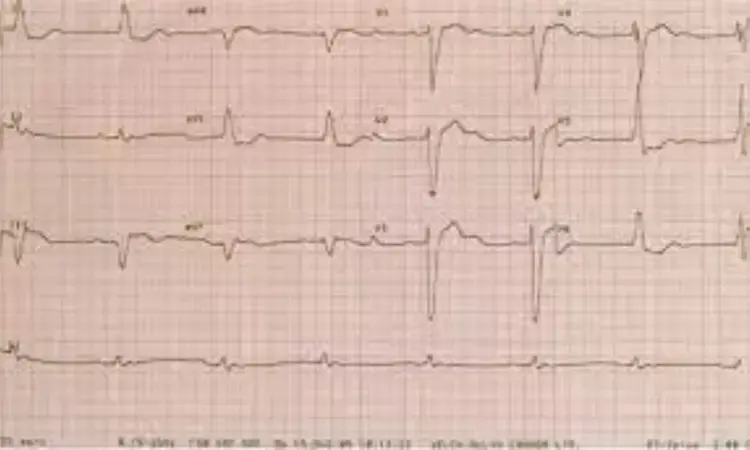- Home
- Medical news & Guidelines
- Anesthesiology
- Cardiology and CTVS
- Critical Care
- Dentistry
- Dermatology
- Diabetes and Endocrinology
- ENT
- Gastroenterology
- Medicine
- Nephrology
- Neurology
- Obstretics-Gynaecology
- Oncology
- Ophthalmology
- Orthopaedics
- Pediatrics-Neonatology
- Psychiatry
- Pulmonology
- Radiology
- Surgery
- Urology
- Laboratory Medicine
- Diet
- Nursing
- Paramedical
- Physiotherapy
- Health news
- Fact Check
- Bone Health Fact Check
- Brain Health Fact Check
- Cancer Related Fact Check
- Child Care Fact Check
- Dental and oral health fact check
- Diabetes and metabolic health fact check
- Diet and Nutrition Fact Check
- Eye and ENT Care Fact Check
- Fitness fact check
- Gut health fact check
- Heart health fact check
- Kidney health fact check
- Medical education fact check
- Men's health fact check
- Respiratory fact check
- Skin and hair care fact check
- Vaccine and Immunization fact check
- Women's health fact check
- AYUSH
- State News
- Andaman and Nicobar Islands
- Andhra Pradesh
- Arunachal Pradesh
- Assam
- Bihar
- Chandigarh
- Chattisgarh
- Dadra and Nagar Haveli
- Daman and Diu
- Delhi
- Goa
- Gujarat
- Haryana
- Himachal Pradesh
- Jammu & Kashmir
- Jharkhand
- Karnataka
- Kerala
- Ladakh
- Lakshadweep
- Madhya Pradesh
- Maharashtra
- Manipur
- Meghalaya
- Mizoram
- Nagaland
- Odisha
- Puducherry
- Punjab
- Rajasthan
- Sikkim
- Tamil Nadu
- Telangana
- Tripura
- Uttar Pradesh
- Uttrakhand
- West Bengal
- Medical Education
- Industry
ECG images with AI useful for screening of LV systolic dysfunction

USA: The researchers have developed and externally validated a deep-learning model that can be leveraged to identify left ventricular (LV) systolic dysfunction from ECG images. The findings were published online in the journal Circulation on 25 July 2023.
"Their approach also appears able to identify individuals who don’t yet have LV systolic dysfunction but are at increased risk of developing it in the future, particularly in low-resource settings," the study stated. The study applied artificial intelligence (AI) to nearly 400,000 12-lead ECGs and corresponding echocardiographic data from the same patients.
Previous studies have shown that left ventricular systolic dysfunction is linked with a more than 8-fold increased heart failure risk and a 2-fold risk of premature death. ECG signals use in screening for LV systolic dysfunction is limited by their availability to clinicians. Veer Sangha, Department of Computer Science, Yale University, New Haven, CT. (V.S., A.K.), and colleagues developed a novel deep learning–based approach that can use ECG images for the screening of LV systolic dysfunction.
They developed a convolutional neural network algorithm for detecting an LV ejection fraction <40% using 12-lead ECGs plotted in multiple different formats, and corresponding echocardiographic data recorded within 15 days from the Yale New Haven Hospital between 2015 and 2021. They validate the model within clinical settings from different centres in the US. Furthermore, it was also validated in the prospective Brazilian Longitudinal Study of Adult Health. To localize class-discriminating signals in ECG images, gradient-weighted class activation mapping was used.
The study revealed the following findings:
· 385 601 ECGs with paired echocardiograms were used for model development.
· The model showed high discrimination power across various ECG image formats and calibrations in internal validation (area under receiving operation characteristics [AUROCs], 0.91; area under precision-recall curve [AUPRC], 0.55); and external sets of ECG images from Cedars Sinai (AUROC, 0.90 and AUPRC, 0.53), outpatient Yale New Haven Hospital clinics (AUROC, 0.94 and AUPRC, 0.77), Memorial Hermann Southeast Hospital (AUROC, 0.91 and AUPRC 0.88), Lake Regional Hospital (AUROC, 0.90 and AUPRC, 0.88), Methodist Cardiology Clinic (AUROC, 0.90 and AUPRC, 0.74), and Brazilian Longitudinal Study of Adult Health cohort (AUROC, 0.95 and AUPRC, 0.45).
· An ECG suggestive of LV systolic dysfunction portended a >27-fold higher odds of LV systolic dysfunction on transthoracic echocardiogram (odds ratio, 27.5 in the held-out set).
· Class-discriminative patterns localized to the anterior and anteroseptal leads (V2 to V3), corresponding to the left ventricle regardless of the ECG layout.
· A positive ECG screen in individuals with an LV ejection fraction ≥40% at the time of initial assessment was associated with a 3.9-fold increased risk of developing incident LV systolic dysfunction in the future (hazard ratio, 3.9 median follow-up, 3.2 years).
"We developed and externally validated a deep learning model for identifying LV systolic dysfunction from ECG images," the researchers wrote. "This approach represents an accessible and automated screening strategy for LV systolic dysfunction, specifically in low-resource settings."
Reference:
Sangha V, Nargesi AA, Dhingra LS, Khunte A, Mortazavi BJ, Ribeiro AH, Banina E, Adeola O, Garg N, Brandt CA, Miller EJ, Ribeiro ALP, Velazquez EJ, Giatti L, Barreto SM, Foppa M, Yuan N, Ouyang D, Krumholz HM, Khera R. Detection of Left Ventricular Systolic Dysfunction From Electrocardiographic Images. Circulation. 2023 Jul 25. doi: 10.1161/CIRCULATIONAHA.122.062646. Epub ahead of print. PMID: 37489538.
Dr Kamal Kant Kohli-MBBS, DTCD- a chest specialist with more than 30 years of practice and a flair for writing clinical articles, Dr Kamal Kant Kohli joined Medical Dialogues as a Chief Editor of Medical News. Besides writing articles, as an editor, he proofreads and verifies all the medical content published on Medical Dialogues including those coming from journals, studies,medical conferences,guidelines etc. Email: drkohli@medicaldialogues.in. Contact no. 011-43720751


